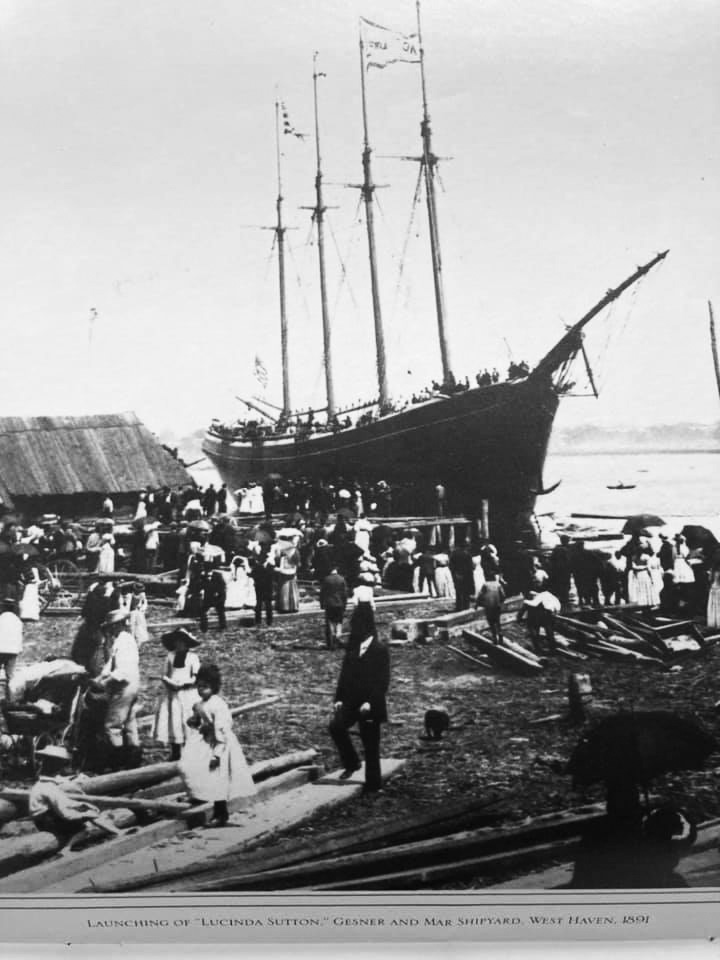By Dan Shine
Voice Columnist

The Lucinda Sutton
In past Historian’s Corners, we have touched very briefly upon the history of the four-masted schooner Lucinda Sutton. Thanks to some special help from Bill Lang, we are able to more fully recount her life and her fate.
Henry Sutton was a shipowner and a ship chandler: These are merchants who supply goods for ships. They stock up on all the essentials that meet the needs of various vessels. These items include leather goods, galley supplies, lanterns, hooks, brooms, mops, varnish, tallow, etc. At age 29, Sutton had branched out from his grocery business, and had begun owning seagoing vessels, which were sort of the eighteen-wheel trucks of the late Nineteenth Century. Along the way, he became quite successful.
In all, he had seventeen ships built for his commercial purposes, and the Lucinda Sutton—named for his wife–built in 1891 was the largest of them, measuring 225 feet long, and capable of carrying 2500 tons of cargo. Equipped with hundred-foot masts, she had a steam engine on board to hoist the ship’s enormous sails, spars and anchors, as well as to load and discharge cargo. Construction was handled by the Gesner and Mar Shipyard on Water Street, where her gargantuan profile eventually dwarfed the neighboring houses.
Once the construction was completed, the launching of such ships were colorful and exciting events: Crowds numbering in the thousands were common, and the launching of the Lucinda Sutton was no exception. Long before the appointed hour, the dusty streets around Water Street were all choked with hacks, coupes, beach wagons, express wagons, horse railroad cars and fine private teams destined for the big show. And out on the water were a mass of sloop yachts, sharpies, cat boats and row boats, filled with those parties who wished to witness the event.
And there were bands, speeches and plentiful libations to make the day more interesting. And thus the ceremony went on and on through the heat of July 21, 1891. Finally, a group of laborers with iron wedges knocked away the keel blocks and with a slow creaking sound, the Lucinda Sutton began to slide down the launching ways, which had been generously slushed with grease.
It was not uncommon for ships to be launched into the West River’s shallow channel only to become stuck in the mud, and the Lucinda Sutton was no exception: Throughout the ceremony, over three hundred souls had been on deck; however, some of the more experienced thought it prudent to return to shore before the launching: They were the lucky ones. Those who remained on board had to wait to be removed from the ship via wooden ladders. Then, the great ship remained stuck in the mud and waited for time and tide to set her free, three days later.
The Lucinda Sutton sailed successfully for the next twenty-five years, during which time she suffered two collisions and a generally deteriorating condition. Leaking badly, the ship was sold in 1916, and subsequently ran aground in the treacherous waters off the central coast of Argentina and was stranded. The ship’s life ended as it had begun, stuck in the mud. It was declared a total loss. But one man’s loss can be another man’s windfall. Much of the ship’s cargo of lumber washed up on shore, was gathered up and used in the construction of a bathing spa at Monte Hermosa. In time, this facility turned into a popular little seaside resort.
This is just one small story out of many which deal with West Haven’s long association with the sea.
To Dan Shine;
I have long enjoyed your articles especially those taking us back to earlier days in our town. I recently began to wonder about the area we call ‘the airport’ where all those single homes were built, I believe, after WW2, for returning men and their families.
This prompted me and a friend who also grew up in West Haven, to wonder about other small airports in our state. I seem to remember one in Bethany when I was young, and perhaps a look back at those now defunct airports, what has become of that land, and maybe some history about them. \
Given the location of the West Haven one, some wag said it was a rich man’s airport, with those small planes making hops from CT over to Long Island, or points in New York. Any truth to this?